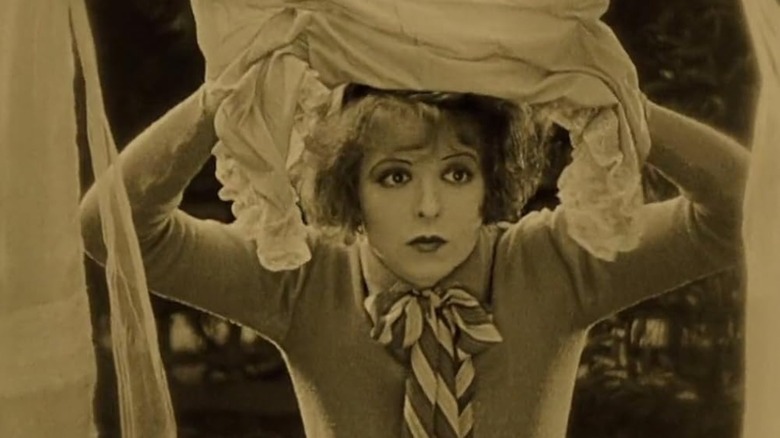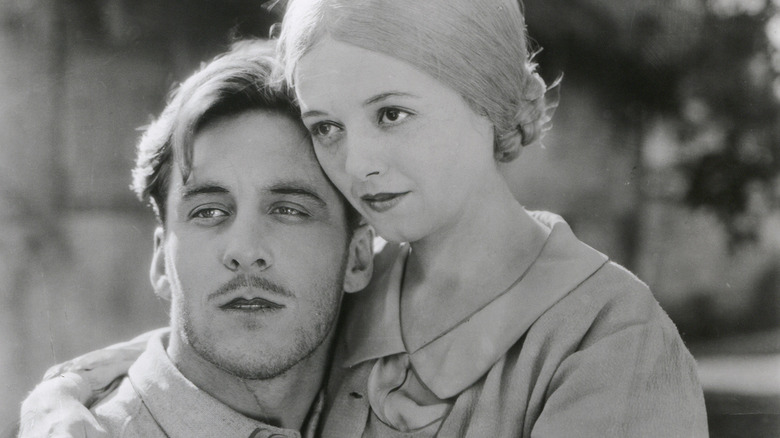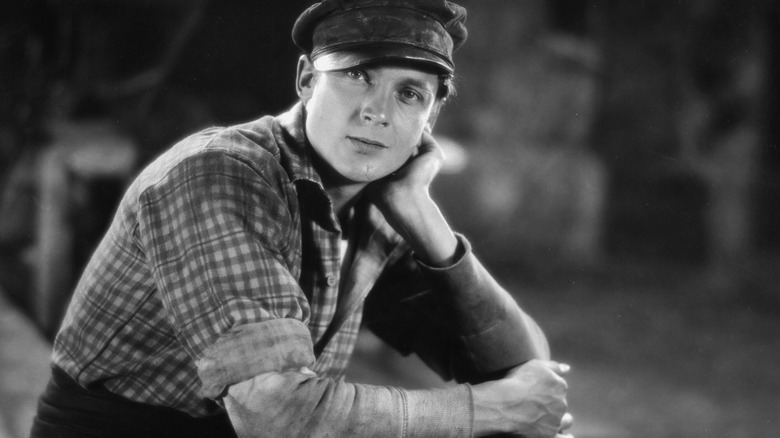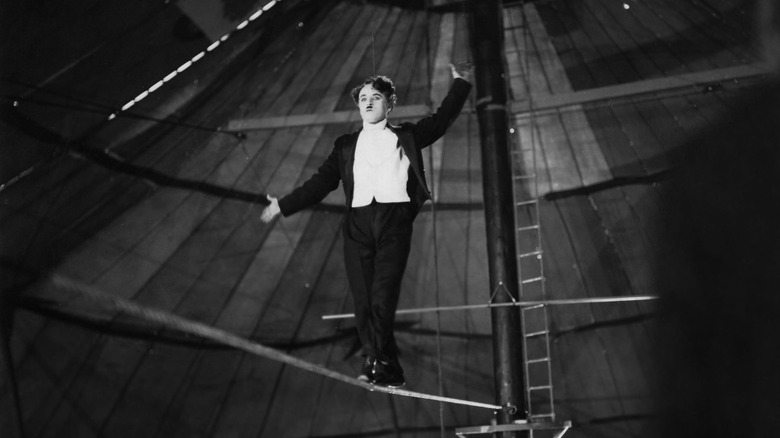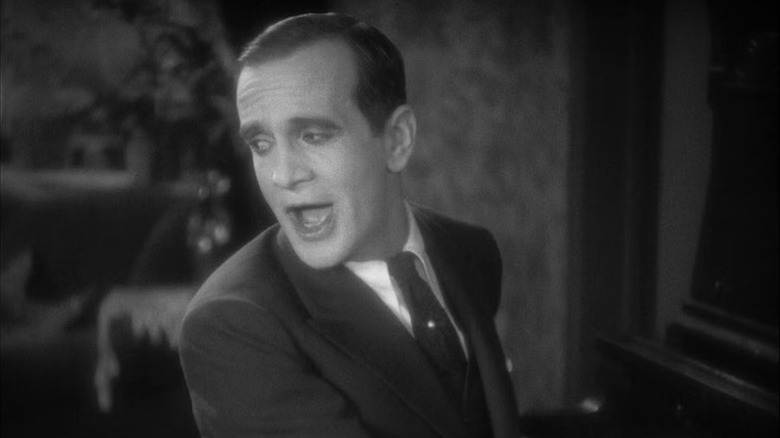5 Fascinating Facts About The First-Ever Oscars
We may receive a commission on purchases made from links.
The very first Academy Awards were held on May 16, 1929, in the Blossom Room of the Hollywood Roosevelt Hotel. Douglas Fairbanks, one of the biggest stars of his time, presented every single one of the awards. Right away, the timing was a little off, as the Oscars didn't adhere to specific calendar years for their awards. Instead, the awards were given to all the films released between August 1, 1927, and July 31, 1928.
The Academy continued with the "straddle" schedule for its first five years, considering a "release year" to be August 1 to July 31. Perhaps wanting to keep things a little cleaner, the Academy expanded the year of the 6th Academy Awards, which considered all the films released from August 1, 1932, all the way to December 31, 1933. The 7th Oscars (1934, the year "It Happened One Night" won Best Picture) was the first Oscars to finally measure by a proper calendar year. The Awards have been following that pattern ever since.
2025 will mark the 97th Oscars ceremony, and it's been a wild near-century of American film. Numerous categories have been introduced and dropped, and new eligibility rules are always being invented, causing a frustrating taxonomy scramble in audiences' minds. We have seen the rise of concepts like "Oscar buzz," "snubs," and honed our understanding of red carpet protocol. Hollywood's film release schedule has been completely altered to match the perceived whims of Oscar voters; so-called "prestige" pictures are typically released at the end of a calendar year, as to keep them fresher in people's minds. We've even seen the rise of "Oscar bait," a type of high-profile Hollywood drama whose making appears to be motivated by the need to win awards more than any sense of art or personal passion. The Oscars, in short, completely reshaped Hollywood.
Hence, it's valuable to look back to the very first Oscars and note the major differences between then and now.
There were two Best Pictures and two Best Directors
Typically, William Wellman's "Wings" is considered the very first Best Picture winner, and it's always listed as such in retrospectives. Indeed, at the Kodak Theater on Hollywood Blvd. (where the Oscar ceremony is now traditionally held) each Best Picture winner is given an outsize plaque along the theater's main entryway, and "Wings" is prominently displayed first.
Absent from all the lists, however, is F.W. Murnau's Best Picture winner "Sunrise: A Song of Two Humans," which ought to count at least as much as "Wings." At the first Oscars, there were two categories for the top prize: Outstanding Picture and Best Unique and Artistic Picture. "Wings" took home Outstanding Picture, beating nominees "The Racket" and "7th Heaven," while "Sunrise" won Best Unique and Artistic Picture over the documentary "Chang" and King Vidor's "The Crowd." All of these films were silent movies.
Additionally, there were two Best Director categories in 1929, separated by genre. Best Directing (Comedy Picture) was given to Lewis Milestone for "Two Arabian Knights," while Best Director (Dramatic Picture) was awarded to Frank Borzage for "7th Heaven." The separation of comedy and drama goes a long way to explaining the way Hollywood, even to this day, still thinks about motion pictures. That is, there are only two genres of note, comedy and drama, any every other genre is either not worth a look or a subcategory. It would take many years before genre pictures (that is: horror, action, and sci-fi) would be recognized by the Academy at all, and there still seems to be a distant, lingering prejudice against them.
This is, of course, an arbitrary distinction, as "Wings" is an interpersonal drama about soldiers, but it's also an action film. Of course, when action and sci-fi movies tend to make a billion dollars each, maybe handing them a statuette is a consolation prize.
The ceremony was only 15 minutes
There was one host: Douglas Fairbanks (Zorro himself!). He read the names of all the winners. The awards were distributed. Bam, the night was over. There were no tributes, no speeches, and maybe a few jokes. Attendees sat at dinner tables. It was an efficient affair. Of course, there was no tension; the winners had already been announced several months earlier.
In contrast, the 96th Academy Awards telecast lasted three hours and 23 minutes. Indeed, most Oscar ceremonies now last about 210 minutes on average, with some running as long as 230 — and that's considered brief. The 2002 Oscars, hosted by Whoopi Goldberg, ran four hours and 23 minutes. This is to accommodate thank-you speeches, 20-plus categories (the number of categories keeps changing), dance numbers, an opening standup routine, special awards, commercial breaks, and a wistful memorial reel. And that doesn't even include the live televised red carpet shenanigans, wherein fans can watch their favorite actors parade into the theater, all wearing their Sunday finest. If one were dedicated, a viewer could stay glued to Oscar news for six straight hours.
The length of the Oscars has become a topic of some controversy. Whenever ratings of the Oscars telecast begin flagging, producers and pundits begin to theorize that the show's overwhelming length is to blame. They try cutting Oscar categories from the telecast or slicing down the musical numbers, hoping that a 200-minute show would be more appealing than a 210-minute show. It might be wiser to simply embrace the length and acknowledge that the Oscars are an all-day affair.
Meanwhile, in 1929, the ceremony was over before attendees could finish their entrées. It's wild to think that brevity used to be a natural part of the show.
Actors were nominated for a body of work, and there were already honorary awards
Janet Gaynor won the very first Academy Award for Best Actress, but it wasn't for any one particular film. She was awarded for her overall work in the films "7th Heaven," "Street Angel," and "Sunrise." She may have had an advantage over her competitors, Louise Dresser and Gloria Swanson, as they were only nominated for one role each. The same is true of the first Best Actor winner, Emil Jannings, who was recognized for his work in both "The Last Command" and "The Way of All Flesh." He won over Charlie Chaplin's performance in "The Circus" and Richard Barthelmess' performances in "The Patent Leather Kid" and "The Noose." After the first Oscars, however, acting nominees were relegated to single performances in single films. Recognizing an actor's whole body of work may be a good way to understand their range, but it also unfairly favors actors who are able to gain more employment.
Even with the leeway of multiple films per actor, the Academy still had honorary awards its first year. Chaplin's "The Circus" was initially nominated for Best Actor, Best Director, and Best Writing (Original Story), but the Academy decided to rescind those nominations in favor of a special recognition Oscar.
Also, in what seems like a suspiciously corporate move, the Academy also gave an Honorary Award to Warner Bros. for producing Alan Crosland's "The Jazz Singer," a film notable in cinema history of its revolutionary use of sound. "The Jazz Singer" has long been called the first-ever talkie, although it would be more accurate to say that it was the first feature-length film with synch sound, of both singing and talking, used throughout its running time. Regardless, its popularity helped usher in the sound era.
It wasn't televised or announced on the radio
For the bulk of its history, the Oscars have been a televised event, with the first Oscar ceremony being broadcast live in 1953 (the year "The Greatest Show on Earth" won). Prior to that, the Oscars were covered live on the radio and listeners tuned in en masse.
Weirdly, though, there was no broadcast media present at the very first Oscars. Microphones weren't brought into the awards hall until the second Oscars in 1930. Perhaps the absence of sound was appropriate for the first Oscars, seeing as all the nominees (but one) were silent films. Once sound films took off, silent films stopped getting made with the same frequency. It wouldn't be until 2011's "The Artist" won the top award that silent movies would be recognized again.
According to a report from NPR, there was a lot of chaos behind the scenes throughout the first five years of the Academy Awards because of the motivations behind its founding. As one will read below, the Oscars were invented as an anti-union measure, and a lot of the talent and the studios butted heads with the muckety-mucks in charge. As such, the Oscars needed to goose up its image a little bit, and broadcast media was the best way to do it. Media outlets began reporting on the outfits and the opulence of the ceremony, equating Hollywood's power players with glitz and glamour. Audiences became Oscar hounds thanks to these "prom night"-like broadcasts. From then on, it would become part of the Oscars' DNA to present as big a show as possible.
They were an anti-union measure
It may not surprise one to learn that the Oscars were not founded for wholly savory reasons. As previously written about in the pages of /Film, the Oscars were not invented to celebrate the art of film or to recognize the talents and efforts of Hollywood's elite, but to distract workers from their potential unionizing efforts.
What we now call "The Academy" is the Academy of Motion Picture Arts and Sciences, and it was founded by studio mogul Louis B. Mayer in 1927. The story goes that Mayer wanted a ritzy home in Santa Monica, California, and he employed studio construction workers — whowere asked to work 24-hour shifts — to get it done as quickly as possible. Unions, of course, guaranteed that the workers be allowed breaks and overtime pay, which, to Mayer's greedy eyes, only drove the price up. Mayer took a dim view of unions as a result. Thus, he founded the Academy as a negotiating body, knowing that his many employees at Metro-Goldwyn-Mayer could break his fortune if they ever unionized.
As such, Mayer came up with the Academy Awards, a prestigious, completely manufactured event, as a way to make his talent feel special and recognized ... without having to give anyone raises.
This is a matter of record. In Scott Ayman's biography "The Lion of Hollywood," Mayer was quoted as saying, "I found that the best way to handle [talent] was to hang medals all over them. [...] If I got them cups and awards they'd kill themselves to produce what I wanted. That's why the Academy Award was created."
It didn't work. SAG and the WGA were both founded in 1933, while the DGA was formed in 1936. Of course, given how much ink is spilled on Hollywood's annual "Oscar race," one might still see the ceremony as a grand distraction from the industry's deeper problems.
